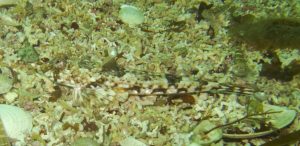Guiding divers in Dingle we always took an interest in identifying the species that we had seen, we had a few guidebooks including the British Marine Life ID guide. One of our most accessible dive sites has been known by many names over the years including “The gravelly” and “Thornback alley”, it is a shallow dive within the bay which is home to great diversity. The Eastern part of the site is characterised by a sandy, muddy and gravelly substrate teeming with life barely visible until disturbance sends them darting in all directions, and it was here that I first identified a Common dragonet, Callionymus lyra Linnaeus, 1758, or was it?
Fast-forward 10 years to the third year of a Freshwater and Marine Biology degree, and it is only now that I have discovered the presence of another member of the genus in our waters. I may even have already observed it without realising. So why was the Callionymus reticulatus left out of the guidebooks for so long.
Well, they are tricky little fishes. In fact, Linnaeus when first describing the Callionymus lyra in 1758 believed that the female was a distinct species. The Reticulated dragonet was not described until 1837 by Valenciennes (Darwin, 1871). They are a truly beautiful fish with males particularly well deserving of the name dragonet, the striking colours, flattened triangular shaped head and pectoral fins which when fanned out could resemble wings, the elongated tail and striking dorsal fins.


Identification features described in those dichotomous scientific identification guides containing both species often come down to things like the shape/direction of the pre-opercular spines for example, or measurement references for the relative length of the head. These are not useful ID features for the field observer of course whose subjects are not dead, hopefully. Other identification features such as the observation of the erect first dorsal fin in the male if seen, is a definitive species ID feature. The distinguished saddle markings on the reticulatus which can be seen in Image 2 can also be used. The females and juvenile males are trickier to tell apart by eye.
This project aims to investigate the distribution of both species using all obtainable records and try to determine whether the Reticulated dragonet is rare or overlooked. The data is limited, and I will need all the help I can get, I plan to interview experts in the field, analyse all the existing data, and develop a photographic quiz. I will be asking Seasearch Ireland members for participation. Any photos or stories you would like to share please contact me at lisanihill@gmail.com. The Seasearch data will be of deep interest to me given the added details of habitat and substrate type. I will be updating the blog weekly and will share all my discoveries and queries, all suggestions, advice and/participation will be gratefully received.
Until next time, wishing I was underwater with you all, Lisa Nihill.
References
Darwin, Charles. The Descent of Man: And Selection in Relation to Sex. London: J. Murray, 1871.
World Register of Marine Species. (WoRMS, 2019)

Very interesting!